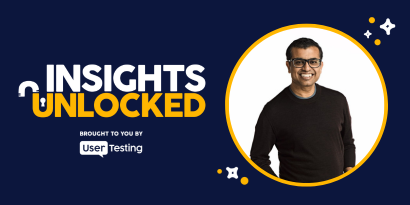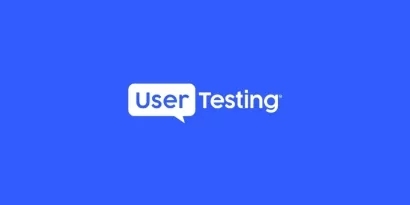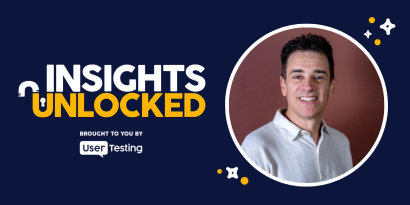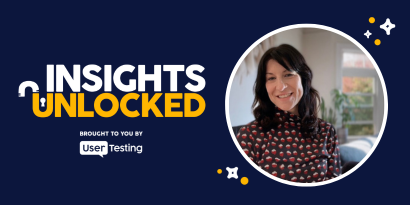
Episode 172 | May 26, 2025
Using AI to streamline and elevate UX research
Google’s Alita Kendrick shares how generative AI is transforming UX research—cutting analysis time, boosting insights, and enhancing storytelling.
How generative AI is reshaping UX research: Lessons from Google’s Alita Kendrick
What if the biggest productivity boost in your UX research toolkit didn’t come from a new method—but from a machine?
In a recent episode of Insights Unlocked, Alita Kendrick, a UX researcher at Google leading accessibility research for the Google Cloud Platform, pulled back the curtain on how generative AI is transforming the entire research process—from planning and analysis to democratizing insights and amplifying storytelling.
With AI tools now firmly embedded in her day-to-day workflow, Alita’s perspective is both pragmatic and inspiring. She’s not just using generative AI to automate tasks—she’s using it to unlock new ways of thinking, collaborating, and delivering value at scale.
Let’s dive into what this shift means for UX professionals, and how you can apply these lessons to your own practice.
The evolving UX toolkit: From Post-it notes to powerful prompts
If you’ve ever mapped out a project on a whiteboard full of sticky notes, you’ll relate to Alita’s evolution. “Since the beginning of my career, I’ve been that person with a big post-it board,” she said. But today, she’s mind-mapping ideas with voice commands in Gemini, Google’s generative AI platform.
Her point? The UX toolkit is evolving fast—and embracing AI isn’t just about saving time. It’s about enhancing how we think and work.
“Sometimes the physical labor of typing or writing is just a blocker,” she said. “I just want to speak and generative AI has been fantastic for that.”
ON-DEMAND WEBINAR
Effective AI: how to choose the right generative AI features—and build them fast
Where AI fits in the UX research lifecycle
Alita broke down how AI plays a role at every stage of the UX research lifecycle. Here’s a look at where she finds the most value:
- Planning and documentation: Drafting project timelines, stakeholder communications, and participant outreach with AI tools like Gemini has sped up pre-research tasks dramatically.
- Study design: Alita uses AI to help generate screener questions, refine research plans, and even pressure test assumptions from different stakeholder perspectives.
- Data analysis: This is where generative AI truly shines. AI tools help her synthesize large amounts of qualitative data, flag themes, and reduce analysis time from weeks to days.
- Storytelling and insight delivery: With more time unlocked, Alita focuses on translating findings into impactful stories that resonate across teams and influence action.
“AI is great for the analysis—but it’s not going to tell your story for you.” – Alita Kendrick
The power of “halfway checks” and AI co-pilots
One of Alita’s most insightful strategies is what she calls the “halfway check.” Midway through a study, she’ll feed transcripts and research questions into Gemini to evaluate if she’s answering the right questions—or missing any key signals.
It’s like having a second set of eyes that never gets tired. This check helps her adapt mid-study, refine her focus, and ensure her insights hit the mark.
This approach highlights a key benefit of AI in user research: it doesn’t just save time—it improves quality through continuous, objective feedback.
Using AI to identify—and challenge—bias
It’s no secret that all researchers carry some degree of bias. But Alita argues that AI can serve as a kind of mirror, helping researchers identify their own blind spots.
“We talk a lot about bias in the models, but not enough about how AI can help us spot our own,” she explained. “Especially in how we interpret or overemphasize certain themes.”
By comparing her own interpretations with AI-generated summaries, Alita finds opportunities to refine her conclusions and stay grounded in the data—a crucial advantage in UX research workflows.
Practical advice for getting started with AI tools
For those just starting out with AI tools for UX researchers, Alita offers this down-to-earth advice: start with the tasks you hate.
For her, that meant drafting stakeholder emails. By using AI to create first drafts, she freed up mental energy for the work that truly matters. Here are a few other entry points she recommends:
- Drafting study guides or screener questions
- Synthesizing transcripts into bullet points or top takeaways
- Repackaging reports for different audiences
- Brainstorming research questions across disciplines
Pro tip: Use prompts like “make sure the survey options are mutually exclusive and collectively exhaustive (MECE)” to improve your survey design with AI’s help.
REPORT
Generative AI chatbots: overhyped but still underestimated
Don’t let imperfect outputs scare you off
According to Alita, one of the most common mistakes is expecting perfect results from the first AI prompt—and giving up when the output misses the mark.
“You need to bring an experimental mindset to your use of AI,” Alita said. “You wouldn’t expect perfect answers from a new teammate on day one—treat AI the same.”
Instead, she recommends refining prompts, adding more context, and using AI as a thought partner rather than a finished solution. In her own practice, she even uses AI to improve her prompts for other AI tools—a meta move that has significantly boosted her creative output.
Democratizing research with AI
Alita also sees generative AI as a powerful enabler of research democratization. She uses AI to help product managers and designers engage with insights earlier in the process—often by tailoring research summaries to their specific lenses.
In fact, she’s repackaging older reports using more creative formats (think: tarot cards for personas) to make past findings more accessible and engaging. As she puts it:
“There’s so much great research already done that gets buried,” she said. “AI can help us resurface and repackage those insights in more resonant ways.”
Custom GPTs, NotebookLM, and other favorite tools
Beyond Gemini, Alita is hands-on with a wide range of tools. Her favorites include:
- NotebookLM – for summarizing dense content like whitepapers or meeting transcripts
- Claude – often used for writing-heavy tasks
- UserTesting’s AI tools – particularly for synthesizing qualitative data quickly
- ChatGPT – for prompt refinement and idea generation
- Midjourney – for creative visual exploration, especially when experimenting with design metaphors
She also builds custom GPTs and agents tailored to her research processes—a move that reflects a broader shift in the field toward more autonomous AI agents in UX research.
From crawl to fly: A mindset shift
Alita encourages researchers to think of AI adoption as a progression:
- Crawl: Use AI to draft emails or stakeholder messages
- Walk: Apply AI to research tasks like study design or data synthesis
- Run: Use AI to co-analyze data, spot gaps, and pressure test insights
- Fly: Build AI agents or custom GPTs that scale research quality and impact
The key is to build habits around experimentation and reflection. Alita even keeps a doc of her favorite prompts—and reviews her AI use quarterly to spot new opportunities.
The future of UX research is collaborative
Looking ahead, Alita is excited about how generative AI will move beyond chat interfaces to become more predictive, personalized, and embedded in daily workflows.
She imagines a future where research tools proactively surface opportunities based on your product context, team goals, and user behavior—like a “second brain” for UX professionals.
But even in this AI-rich future, she emphasizes the human role.
“Generative AI is amazing, but it’s only as powerful as the person using it,” Alita said. “Your context, your judgment, your creativity—that’s still irreplaceable.”
Resources and links:
- Alita on LinkedIn
- Michael on LinkedIn
- Alita’s author site on NNG
- Alita’s Efficient UX course on NNG
- UserTesting's AI-powered capabilities
- Democratizing insights: Blog post on strategies for scaling user research within your organization, emphasizing the importance of democratizing insights to foster a culture where decisions are driven by customer feedback.
- Design for emotion, not usability: Blog post on how generative AI is transforming UX by prioritizing emotional design over mere usability, offering strategies to create AI-driven experiences that resonate deeply with users.









